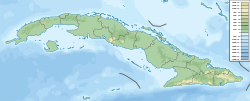| Habana Formation | |
|---|---|
| Stratigraphic range: Late Campanian-Maastrichtian ~ | |
| Type | Formation |
| Sub-units | Titanosarcolites Beds |
| Lithology | |
| Primary | Limestone |
| Location | |
| Coordinates | 22°12′N79°48′W / 22.2°N 79.8°W |
| Approximate paleocoordinates | 21°12′N63°36′W / 21.2°N 63.6°W |
| Region | Pinar del Río & Sancti Spíritus Provinces |
| Country | Cuba |
| Type section | |
| Named for | La Habana |
| Named by | Robert H. Palmer |
| Year defined | 1934 |
The Habana Formation is a geologic formation in Cuba. It preserves mainly gastropod and rudist fossils dating back to the Late Campanian to Maastrichtian periods. [1] The formation was defined by Robert H. Palmer in 1934. [2]
